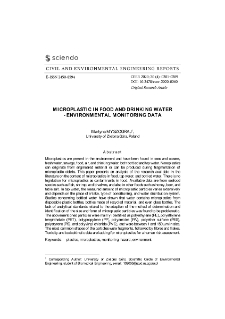Zielonogórska Biblioteka Cyfrowa udostępnia 65 391 obiektów cyfrowych
Obiekt
Tytuł: Microplastic in Food and Drinking Water - Environmental Monitoring Data
Współtwórca:
Tytuł publikacji grupowej:
Abstract:
Microplastics are present in the environment and have been found in seas and oceans, fresh water, sewage, food, air, and drinking water, both bottled and tap water. Nanoplastics can originate from engineered material or can be produced during fragmentation of microplastic debris. ; This paper presents an analysis of the research available in the literature on the content of microplastics in food, tap water, and bottled water. There is no legislation for microplastics as contaminants in food. Available data are from sea food species such as fish, shrimp, and bivalves, and also in other foods such as honey, beer, and table salt. In tap water, the measured amount of microplastic particles varies extensively and depends on the place of intake, type of conditioning, and water distribution system. ; Studies concerning bottled water have shown that water contains microplastics from disposable plastic bottles, bottles made of recycled material, and even glass bottles. The lack of analytical standards related to the adoption of the method of determination and identification of the size and form of microplastic particles was found to be problematic. ; The abovementioned particles were mainly identified as polyethylene (PE), polyethylene terephthalate (PET), polypropylene (PP), polyamides (PA), polyether sulfone (PES), polystyrene (PS), and polyvinyl chloride (PVC), and were between 1 and 150 ?m in size. The most common shapes of the particles were fragments, followed by fibres and flakes. Toxicity and toxicokinetic data are lacking for microplastics for a human risk assessment.
Opis:
tytuł dodatkowy: Prace z Inżynierii Lądowej i Środowiska
Wydawca:
Zielona Góra: Oficyna Wydawnicza Uniwersytetu Zielonogórskiego
Format:
Identyfikator zasobu:
DOI:
Strony:
Źródło:
Civil and Environmental Engineering Reports (CEER), no 30, vol. 4
Jezyk:
Licencja CC BY-NC-ND 3.0:
Prawa do dysponowania publikacją:
Biblioteka Uniwersytetu Zielonogórskiego
Kolekcje, do których przypisany jest obiekt:
- Zielonogórska Biblioteka Cyfrowa > Repozytorium > Jednostki organizacyjne > Wydział Budownictwa, Architektury i Inżynierii Środowiska
- Zielonogórska Biblioteka Cyfrowa > Repozytorium > Typy utworów > Artykuły
- Zielonogórska Biblioteka Cyfrowa > Repozytorium > Czasopisma naukowe i serie wydawnicze UZ > Civil and Environmental Engineering Reports (CEER) > Civil and Environmental Engineering Reports (CEER) (2020)
Data ostatniej modyfikacji:
6 lip 2023
Data dodania obiektu:
24 mar 2023
Liczba wyświetleń treści obiektu:
261
Wszystkie dostępne wersje tego obiektu:
https://zbc.uz.zgora.pl/publication/79689
Wyświetl opis w formacie RDF:
Wyświetl opis w formacie OAI-PMH:
| Nazwa wydania | Data |
|---|---|
| Microplastic in Food and Drinking Water - Environmental Monitoring Data | 6 lip 2023 |
Obiekty Podobne
Popenda, Agnieszka Wiśniowska, Ewa Kuczyński, Tadeusz - red.
Słota, Zbigniew Słota, Krzysztof Morcinek-Słota, Anna Kuczyński, Tadeusz - red.
Pająk, Marek Jasik, Michał Greinert, Andrzej - red. Kołodziejczyk, Urszula - red.
Eskvarekova, Erika Wittenberger, Gabriel Senova, Andrea Bakalar, Tomas Harcarufka, Rastislav Kuczyński, Tadeusz - red.
Rosada, Janusz Przewocka, Marta Greinert, Andrzej - red.
Almeida, José C. Kuczyński, Tadeusz - red.
Ormaniec, Paulina Kuczyński, Tadeusz - red.
Majewski, Kamil Artur Myszograj, Sylwia Płuciennik-Koropczuk, Ewelina Kuczyński, Tadeusz - red.

